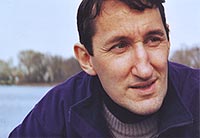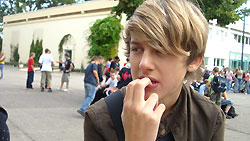|
Interview with Director Michael Gautsch!

Part 3 of “The Little School of Behaviour” comes after a two-year gap. What made you decide to do another episode?
For one, the reaction to part 2 was extremely positive and we also received dozens of suggestions from teachers. We just had to decide whether to film in 2008 or 2009. We then decided to start filming in September 2008.
What kind of suggestions came from teachers this time?
They spanned a whole range of topics that hadn't been covered in the first two parts: for example; correct etiquette at the dinner table and the integration of new students. Also relationships between genders was another topic – the main characters are now in the middle of puberty.
There are some new actors in part 3, the actor playing Max was also replaced.
In fact, we had to recast the role of Max due to scheduling difficulties. Friedrich Kühn, who took on the role, is not only a very natural actor but was also able to subtly portray the very thin line during puberty between rebellion and compromise in the relationship with his mother.

You did, however, stick with the concept of having a positive and negative version.
Yes. However, the structure of the film avoids providing an all too obvious black and white portrayal. A slightly more sophisticated analytical ability is demanded from the students at this age. Part 3 is not just about good and bad behaviour (What am I allowed to do and what am I not allowed to do?) but it's also about what behaviour is appropriate and what is unacceptable.
Content wise, part 3 continues on from part 2: Max now lives permanently with his mother, who has gone back to work after divorcing Max's father.
Yes, we changed Max's familiar surroundings so that we could show new points of conflict: How should he behave in front of his mum's possible new boyfriend? How should he handle the newfound freedom now that his mother is often away for business purposes?
At 44 minutes, part 3 is slightly longer than parts 1 and 2.
That wasn't our intention to begin with. The reason for this was due to the content and the fact that at the age of fourteen, the friendship circle takes on a major role and that some behaviours and moral values are often influenced by those of others. Therefore, we also had to portray the new social environment of the two protagonists.
This time, a main feature of what happens in the school is the integration of a new student.
Yes, an important topic that has also made its way into PSHE (personal, social and health education) lessons in schools. I recently had the opportunity to observe such a class at a school in Potsdam. The students there managed to portray the difficulties involved very convincingly through role play.
In the film, the integration of the new student also takes place in a school zoo, where Max shows the new student Konstantin how to feed the reptiles.
Admittedly, this is a slightly unusual place but it provided an attractive way to get across the idea that integration takes place through collective action.
Did you write this scene first and then look for a suitable school?
No, we already knew of the school with a zoo. They even have a domestic pig in the school grounds – a pink one by the way, not a wild boar which you can also find in the outskirts of Berlin.
You chose a school party as the place to put Max's behaviour to the test in a larger social context.
We decided on this so that we could also address the problem of alcohol consumption, which unfortunately often accompanies events such as these. The school where we filmed this scene had set up its own party room with lighting and music capabilities. However, the room proved to be too small for our purposes so we had to relocate to a room in a theatre.
Like you did previously for the first two parts, did you discuss the finished script with the participating schools?
No, this time we did it differently. We questioned school children anonymously on the relevant topics before we wrote the script – sometimes verbally, sometimes in writing.
What did you discuss?
We talked about, for example, the language used by young people and how widespread it is in schools today. Did it make sense to incorporate this youth language into the film dialogue for reasons of authenticity? We soon rejected this plan, when it came to our attention that there isn't a language common to all youths. Therefore, we just stuck to the classic colloquial language. Other topics discussed were relationships with members of the opposite sex and behaviour at school parties.
Will there be a part 4 to “The Little School of Behaviour”?
This question was already raised by some of the actors during the filming of part 3 and different thoughts were expressed as to how we could continue with a fourth part. If part 3 is successful and there's the demand for another sequel, then of course we will consider it. Part 4 would not, however, necessarily continue on from part 3.
|